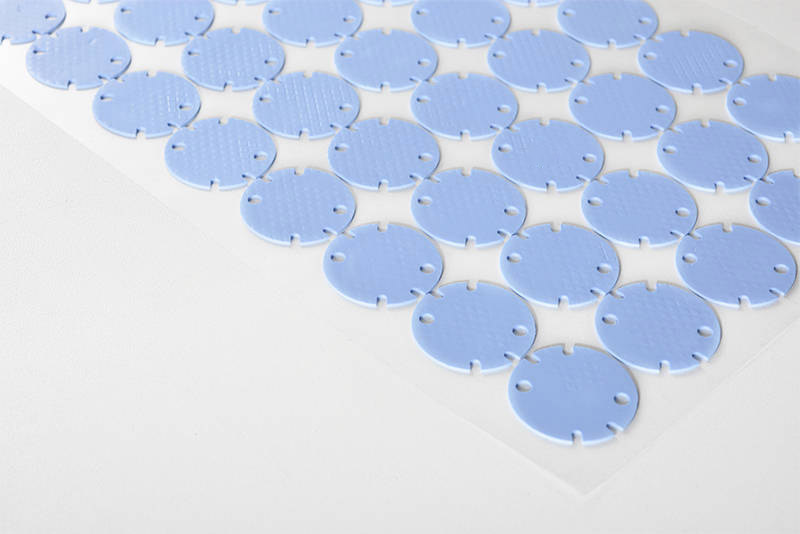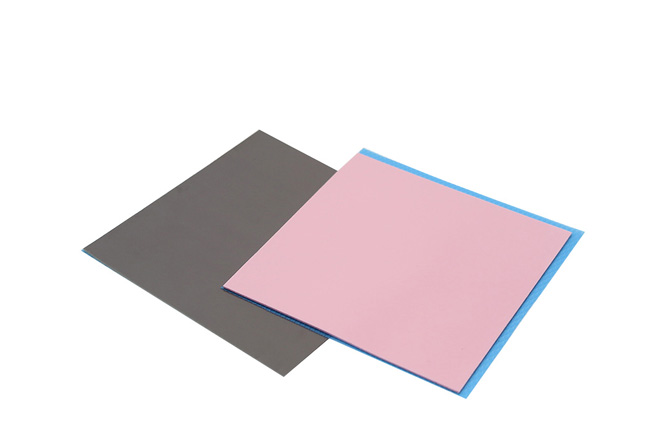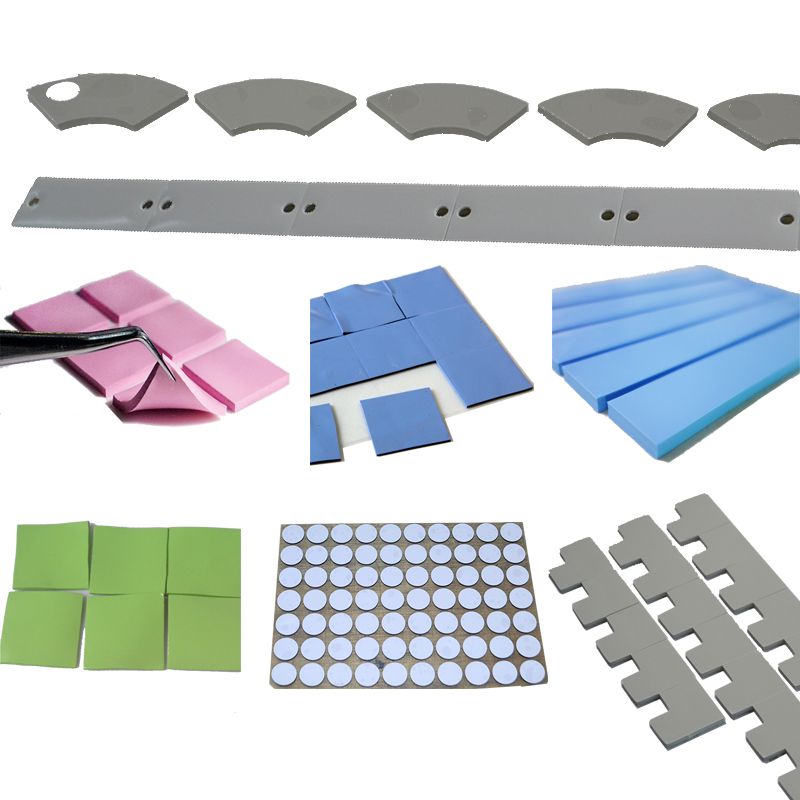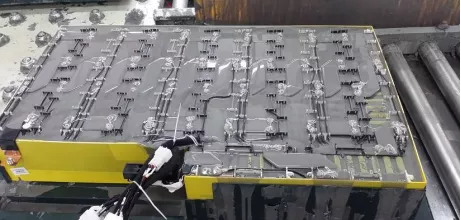Thermal conductive silicone film is a kind of thermal medium material synthesized by adding various auxiliary materials such as metal oxides to silicone as the substrate through special processes. In the industry, it is also known as thermal conductive silicone pad, thermal conductive silicon film, flexible thermal conductive pad, thermal conductive silicone pad film, etc. It is specially produced to utilize gaps to transfer heat. It can fill gaps, complete the heat transfer between the heating and cooling parts, and also has functions such as insulation, shock absorption, and sealing. It can meet the design requirements of equipment miniaturization and ultra-thinness, and is an excellent thermal filling material with wide thickness application range.

The production process of thermal conductive silicone film includes the following steps: raw material preparation → plasticizing and mixing → molding vulcanization → trimming and cutting → inspection, etc. The following briefly introduces the production process of thermal conductive silicone film:
1. Raw material preparation: The thermal conductivity of ordinary organic silicone rubber is usually only about 0.2W/m·K. However, its thermal conductivity can be improved by mixing thermal conductive fillers in ordinary silicone rubber. Common thermal conductive fillers include metal oxides (such as Al2O3, MgO, BeO, etc.), metal nitrides (such as SiN, AlN, BN, etc.). The thermal conductivity of fillers is closely related not only to the materials themselves but also to the particle size distribution, morphology, interface contact, and internal bonding degree of the thermal conductive filler molecules. Generally, fiber-like or foil-like thermal conductive fillers have better thermal conductivity.
2. Plasticizing and mixing: Plasticizing and mixing is a process of silicone processing, which refers to reducing the molecular weight and viscosity of raw rubber by mechanical or chemical methods to improve its plasticity and obtain appropriate fluidity to meet the needs of mixing and further processing. The raw materials for making thermal conductive silicone films are generally mechanically high-speed stirred and destroyed. After color matching and mixing, the milky-white silicone rubber is transformed into various colors of sheet stock.
3. Molding and vulcanization: To produce a flexible, elastic, and tear-resistant thermal conductive silicone sheet, it is necessary to use a silicone gel that has undergone secondary vulcanization. Vulcanization is also known as solidification. After the liquid thermal conductive silicone is heated and molded in the first stage, its cross-linking density is still insufficient. Further vulcanization reaction is required to increase the tensile strength, resilience, hardness, swelling degree, density, and thermal stability of the thermal conductive silicone sheet, which can greatly improve the performance compared with single vulcanization. If secondary vulcanization is not carried out, the performance of the produced thermal conductive silicone sheet may be affected, and the product's performance may not be optimized. The parameters of the product after single vulcanization are not exactly the same as those after secondary vulcanization, which is also related to the actual operation process and steps.
4. Trimming and cutting: The high-temperature treated thermal conductive silicone sheet needs to be placed for a period of time to cool naturally before being cut into different sizes and specifications, and cannot be cooled rapidly by other means. Otherwise, it will directly affect the product performance of the thermal conductive silicone pad.
5. Finished product inspection: The main items that need to be tested for the finished product include thermal conductivity, temperature resistance range, volume resistivity, voltage resistance, flame resistance, tensile strength, hardness, thickness, etc.
Advantages of thermal conductive silicone sheets:
1. The material is soft, with good compression performance and thermal insulation performance, and a large adjustable range of thickness. It is suitable for filling cavities. Both sides have natural stickiness, with strong operability and repairability.
2. The main purpose of selecting thermal conductive silicone sheets is to reduce the contact thermal resistance between the heat source surface and the heat dissipation device. Thermal conductive silicone sheets can effectively fill the gap between the contact surfaces.
3. Since air is a poor conductor of heat and can seriously hinder the transfer of heat between the contact surfaces, the addition of thermal conductive silicone sheets between the heat source and heat dissipation device can squeeze out the air in the contact surfaces.
4. With the supplement of thermal conductive silicone sheets, the contact surface between the heat source and heat dissipation device can be better fully contacted, achieving face-to-face contact with minimum temperature difference.
5. The thermal conductivity of thermal conductive silicone sheets has adjustability, and the thermal conductivity stability is also better.
6. The process tolerance of thermal conductive silicone sheets can compensate for the structural tolerances, reducing the process tolerance requirements of the heat dissipation device and heat dissipation structural components.
7. Thermal conductive silicone sheets have insulation performance (this characteristic needs to add appropriate materials during production).
8. Thermal conductive silicone sheets have the effect of shock absorption and sound absorption.
9. Thermal conductive silicone sheets are convenient for installation, testing, and can be reused.
The disadvantages of thermal conductive silicone film compared to thermal conductive silicone grease are as follows: 1. Although the thermal conductivity is higher than that of thermal conductive silicone grease, the thermal resistance is also higher than that of thermal conductive silicone. 2. The process of thermal conductive silicone film with a thickness of less than 0.5mm is complex, and the thermal resistance is relatively high. 3. The temperature range of thermal conductive silicone grease is larger, with a range of -60℃ to 300℃, while the range of thermal conductive silicone film is -50℃ to 220℃. 4. Price: Thermal conductive silicone grease is widely used and has a lower price, while thermal conductive silicone film is more commonly used in thin and small electronic products such as laptops, with a slightly higher price.
Application fields of thermal conductive silicone film include:
- LED industry: used for thermal conductance between aluminum substrate and heat dissipation fins, as well as between aluminum substrate and casing.
- Power supply industry: used for thermal conductance between MOS tubes, transformers (or capacitors/PFC inductors) and heat dissipation fins or casings.
- Communication industry: used for thermal conductance and dissipation between main board IC and heat dissipation fins or casings, as well as for thermal conductance and dissipation between DC-DC IC of set-top box and casings.
- Automotive electronic industry: thermal conductive silicone film is utilized in xenon lamp ballast, audio, and car-mounted series products.
- PDP/LED TV industry: used for thermal conductance between power amplifier IC, image decoder IC and heat dissipation fins (or casings).
- Home appliance industry: thermal conductive silicone film is used for thermal conductance and dissipation between microwave/air conditioner (fan motor power IC and casing), as well as for thermal conductance and dissipation between hot resistor and heat dissipation fins on electric stove.
Selection of thermal conductive silicone film
The main consideration in selecting thermal conductive silicone film is the size of the heat source power consumption and the heat dissipation capability of the heat sink or heat dissipation structure. Generally, a chip with a low temperature specification parameter, or one that is sensitive to temperature, or has a large heat flux density (generally greater than 0.6W/cm3) needs to be cooled, and it is recommended to choose a thermal conductive silicone film with a higher thermal conductivity.
In the consumer electronics industry, it is generally not allowed for the chip junction temperature to exceed 85 degrees, and it is recommended to control the chip surface temperature below 75 degrees during high-temperature testing. The components of the entire board are also mostly commercial-grade components, so the internal temperature of the system is recommended to be no more than 50 degrees at room temperature. For the first appearance surface or the surface that can be contacted by end customers, the recommended temperature at room temperature should be below 45 degrees. Choosing a thermal conductive silicone film with a higher thermal conductivity can meet design requirements and retain some design margin.
Note:
Heat flux density: defined as the amount of heat passing through a unit area (1 square meter) section in a unit time (1 second).
Junction temperature: it is usually higher than the housing temperature and the device surface temperature. The junction temperature can measure the time required for heat dissipation from the semiconductor wafer to the packaged device housing and the thermal resistance.
Factors affecting the thermal conductivity of thermal conductive silicone gel include:
1. The type and properties of the polymer matrix material: The higher the thermal conductivity coefficient of the matrix material, and the better the dispersibility and bonding between the filler and the matrix, the better the thermal conductivity performance of the thermal conductive composite material.
2. Type of filler: The higher the thermal conductivity coefficient of the filler, the better the thermal conductivity performance of the thermal conductive composite material.
3. Shape of filler: Generally, the order of ease of forming a thermal conductivity path is whiskers > fibrous > flake > particle. The easier it is for the filler to form a thermal conductivity path, the better the thermal conductivity performance.
4. Filler content: The distribution of the filler in the polymer determines the thermal conductivity performance of the composite material. When the filler content is small, its thermal conductivity effect is not obvious; when the filler content is too high, the mechanical properties of the composite material are greatly affected. When the filler content reaches a certain value, the interaction between the fillers in the system forms a thermal conductive network chain similar to a mesh or a chain, and the best thermal conductivity performance is achieved when the direction of the thermal conductive network chain is consistent with the direction of heat flow. Therefore, there is a certain critical value for the amount of thermal conductive filler.
5. Qualities of the interface bond between the filler and the matrix material: The better the bonding between the filler and the matrix, the better the thermal conductivity performance. Suitable coupling agents can be used to treat the surface of the filler, and the thermal conductivity coefficient can be increased by 10%-20%.





Dobon firmly believes that quality is the soul of products, and strictly abides by every standard, every process of production, and every detail of service!
 Send A Message
Send A MessageIf you are interested in our products and want to know more details,please leave a message here,we will reply you as soon as we can.